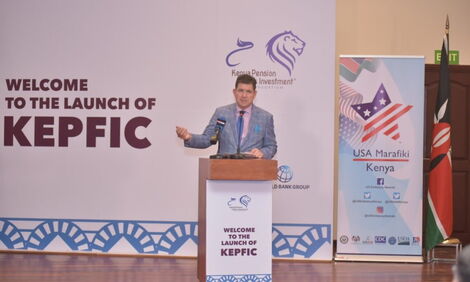-
Central Bank of Kenya (CBK) building in Nairobi. SIMON KIRAGU KENYANS.CO.KE
-
Ksh1.07 trillion from the pension fund was taken up by the national government as part of its domestic debt stock according to the latest Central Bank of Kenya (CBK) weekly bulletin.
According to the report published on March 26, the pensions fund is the government's second biggest lender contributing 30.34% of the total domestic debt. The gross domestic debt currently stands at Ksh3.5 trillion.
Notably, the latest CBK bulletin also revealed that there has been an overall trend of a drop in oil prices around the world, despite the current fuel prices in the country.
"International oil prices continued to decline during the week on account of threat of new lockdowns amid
new Covid-19 infections. Murban oil price declined to $61.61 (Approximately Ksh6,715) per barrel on March 25, from $66.03 ((Approximately Ksh7,200) per barrel on March 18," reads an excerpt from the bulletin. A petrol station attendant pumping fuel into a car.
A petrol station attendant pumping fuel into a car.In the worldwide oil industry, an oil barrel is defined as 42 US gallons, which is about 159 litres. This translates to approximately $0.42 per litre or Ksh45.80.
Commercial banks maintained their position as the government's biggest lender contributing 52.98% of the total domestic debt as of March 2021.
The implication is that the government and citizens are competing for loans from the same commercial banks leading to the crowding-out effect.
Commercial banks prefer to lend to the government since they view it as a low-risk investor as compared to the citizens.
"The Treasury bills auction of March 25, received bids totalling Ksh 22.97 billion against an advertised amount of Ksh 24.0 billion, representing a performance of 95.7%," the report reads in part.
Pension funds in Kenya hold assets under management at Ksh1.3 trillion, a ratio of 13.4% to gross domestic product (GDP).
These cover about 20% of the working population with about 40% invested in securities (Treasury bills and bonds) and earning about Kshh60 billion annually in interest income.
Pension funds generally have longer-term liabilities payable over many years into the future.
On October 21, 2020, former U.S. Ambassador to Kenya Kyle McCarter, together with representatives from the World Bank and American advisory firm MiDA Advisors, launched the Kenya Pension Fund Investment Consortium (KEPFIC).
He went on to detail how KEPFIC would enable pension schemes to jointly make sustainable long-term infrastructure and alternative asset investments in the region.
“The United States Government is pleased to support a Kenyan institution that presents an innovative approach to infrastructure investment in Kenya as it follows recent changes to the Retirement Benefits Authority guidelines allowing pension funds in Kenya to invest up to 10% of their assets into infrastructure, potentially unlocking over Ksh100 billion,” he stated at the time.
Kenya’s annual infrastructure funding gap currently stands at more than Ksh 200 billion, presenting private investors with numerous opportunities in sectors including power, transportation and urban development.
Pension funds are the ideal funding partners for infrastructure projects due to their longer return on investment horizons and significant role in financing infrastructure projects in many countries, including the United States.
 Former US Ambassador to Kenya Kyle McCarter launches the Kenya Pension Fund Investment Consortium on October 21, 2020. FILE Kenyans.co.ke
Former US Ambassador to Kenya Kyle McCarter launches the Kenya Pension Fund Investment Consortium on October 21, 2020. FILE Kenyans.co.ke




